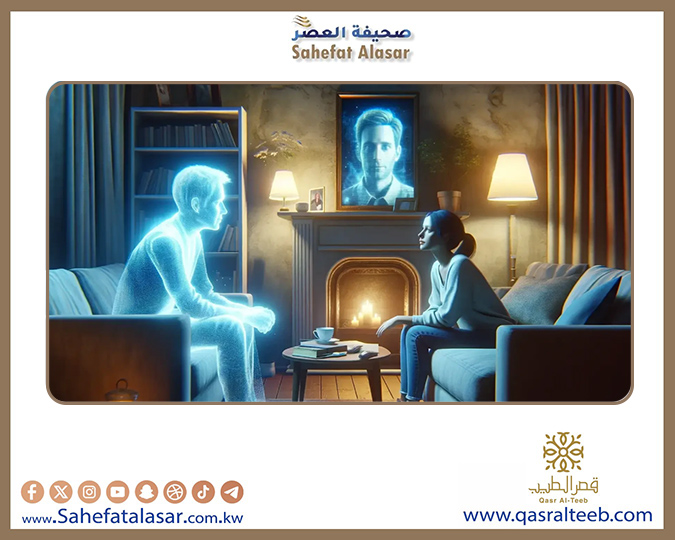


In every home, there is an unforgettable absent person, who left with his body and whose footprint remained alive in the hearts. He left behind an unforgettable void, unforgettable memories, and a voice that still resonates in the ears, even if it is actually faded.
Days pass, and the wheel of life turns, but there are moments that pull us back, when the night is silent and weighed down by stillness, or when we look at an old picture or a situation in which we wished for its presence. At that time, the memory is emitted with all its contents, as if the absence has just happened, as if the heart still refuses to believe.
Mourning for the one we love is a long journey of adjustment, nostalgia, and questioning. Perhaps the most painful part of this journey is what we didn't have time to say, those words we couldn't utter, the questions we didn't answer, or even just the need to hear them one last time, even for a minute.
In our time, with the development of artificial intelligence technologies in an unprecedented way, strange and sometimes influential attempts have emerged, to fill this human vacuum. We are not talking here about the resurrection of the dead, as this is something that only the Creator Almighty possesses, but rather a digital simulation, just an experiment through which some people try to find solace in talking to a virtual version of their deceased loved ones. A version that doesn't have a soul, but it resembles a sound, evoking memories.
In this article, I will tell you a real-life experience that a person lived after the death of his mother. An experience that has a lot of emotions and questions that may shock or surprise some people, or even ask a simple question: Can technology help us overcome sadness, or are there feelings that should not be approached?
Let's dive into the details of this tale together.
How did the story begin? On a corner of Los Angeles, Tony Ken Honest, a 69-year-old director, was contemplating chapters his late mother had written about her childhood in London. She had been dead for nearly a decade, but she left behind an unpublished book of fourteen chapters, which simply recounts her early years between 1928 and 1949.
Here, he decided to do something different. Not to bring her back to life, but to evoke her voice, her tales and her small details in a new way. He used artificial intelligence (AI) and started an ambitious project to make a documentary titled "I Brought My Mum Back to Life with AI."
Using sophisticated tools, Tony copied his mother's voice from old recordings, then combined her restored voice with her original scripts, becoming the film's actual narrator. He did not stop at the sound only, but also used specialized programs to animate her old images, color them and bring them back to life, in scenes that embody her childhood, falling down the stairs and sitting among her relatives.
In the opening scene of the film, an imaginary clip of her birth appears, in her reproduced voice: She entered this world on November 28, in the front room of house No. 1, Prothero Street, in the Fulham area of London. It may seem ordinary to strangers, but for Tony it was an extraordinary moment, in which he felt that the sound he heard had pierced his heart after all these years.
Although some scenes seemed incomplete or strange like some of the cluttered writings or some things that didn't quite resemble reality, the experience itself was strange. Mother's memories are given a new presence that is not like the truth, but touches the heart. As Tony himself described it: "I know it's a strange experience, but I loved it anyway.
When does AI become a consolation? Tony's experience wasn't the first of its kind, but it did highlight a profound question: Can AI touch anything of our emotions? To compensate, even a little, for the heavy loss left by the departure of loved ones?
For Tony, his goal was not to deceive himself, not to create an illusion in which to live, but to give his mother's memory a new form, a different way of telling her story. This was not a "revival" in the usual sense, but a kind of symbolic simulation, which carries with it some solace.
Many people found in this experience an echo of their own feelings, as AI technologies have become a new way to touch memories, not to move beyond death, but to understand and live with it. Many companies have begun offering similar services, allowing users to reconstruct a virtual persona of their deceased loved ones through audio recordings, photos, or even old text messages, producing conversations that mimic their style and way of expression.
But this helloA questioner, despite her consolation, is not without psychological costs. Some find it solace and breathing, while others may find it exhausting or confusing, especially when they feel on the verge of confusing reality with illusion. Does talking with an animated image of a departed mother help healing? Or does it delay and deepen the sense of sadness?
Tony himself admitted that the experience was "strange" and that hearing his mother speak again was very moving, but at the same time he sees it not as a danger or manipulation of emotions, but rather a new form of family storytelling, thanks to tools that were not previously available.
Perhaps the answer lies in the intentions of those who use this technology, and in their realization that it is not a substitute for loss, but a way to deal with it with some calm and nostalgia.
Related Apps & Tools In recent years, advanced AI-based technologies have emerged that allow individuals to retain the memories of their loved ones in new ways, by documenting their voices and images and even simulating symbolic dialogues that help immortalize their biography.
Voice cloning
tools Vidnoz AI Voice Clone: Used to reproduce audio through audio recordings or videos, available to users for free or at little cost, it helps produce familiar sound that resembles a person's real voice.
ElevenLabs Voice Lab: According to an experiment at Reddit, someone used it to clone the voice of his deceased father for about $1 per month, and produced recordings that accurately mimic his voice.
Respeecher: A specialized Ukrainian company, used in particular in the manufacture of film and musical content to reproduce famous voices or personalities who have died with a legal license.
DeepBrain
AI Re; Memory 2: Allows the creation of an avatar, an animation of a deceased person using only one image and ten seconds of voice, so that the user can chat with him by default.
HereAfter AI: Conducts audio interviews with the person while they are alive to store their memories, and then allows interaction with that "avatar" after death.
StoryFile and Replika: Paid platforms for creating conversational experiences with virtual versions of people based on user-provided data.
